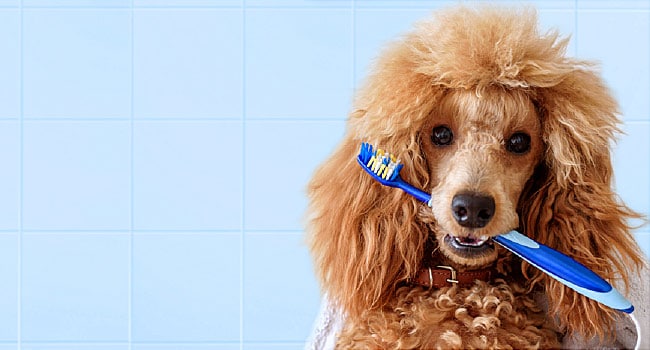Brush Your Pet’s Teeth! On this first month of 2019, make your pet’s health a priority for the coming year. Brushing your pet’s teeth leads to improved health and happiness. Dental disease is a common condition affecting pets, with more than 75 % of dogs and cats showing signs of periodontal disease by age three. Apart from bad breath, it is difficult to recognise the symptoms of dental disease. If left untreated, it can lead to irreversible problems within the oral cavity and even organ disease. Fortunately, dental disease is completely preventable and easy to manage by brushing your pet’s teeth.
What Causes Dental Disease?
Every time your pet eats, a sticky film of food particles, bacteria, and saliva known as plaque forms over each tooth. Consistent exposure to plaque causes gum inflammation, known as gingivitis, as the immune system fights the bacteria within the plaque. Gradually, plaque creeps under the gum’s surface, forming a pocket of bacteria between the gum and the tooth root. This plaque can harden, and the pockets deepen, resulting in irreversible damage like gum recession, tooth decay, root abscesses, and eventually tooth loss.
Why Brush Your Pet’s Teeth?
Fortunately, dental disease is completely preventable with toothbrushing. While dental diets, chews and toys promote good oral health, only toothbrushing completely removes plaque. If you’re unsure whether brushing your pet’s teeth is worthwhile, remember:
- While the early stages of dental disease are reversible, if left untreated your pet may face gum recession, tooth decay, root exposure, abscesses and eventually tooth loss. Brushing your pet’s teeth will save money on dental bills in the long run.
- Long-term gingivitis and gum recession allow nasty bacteria into the bloodstream. These bacteria can travel to organs including the heart, kidneys, liver, lungs and brain, causing serious infection and organ dysfunction.
- Untreated periodontal disease can be extremely painful; however, pets will rarely show signs of oral pain. Your pet may be suffering from long-term, crippling dental pain in silence.
- Clean, healthy teeth will mean a pet with fresher breath!
When to brush your pet’s teeth?
Train your pet to accept toothbrushing as early as possible. Young animals are much more receptive to having their mouths touched and starting early means toothbrushing will become just another part of their daily routine! However, if your pet is older or adopted, don’t despair! It’s never too late to start implementing an oral health routine- the training may just take longer. Have a chat with your veterinarian to assess your pet’s current dental health.
How to brush your pet’s teeth?
Your veterinarian will demonstrate the best technique to brush your pet’s teeth. The toothbrush size will depend on your pet, though many soft-bristle toothbrushes and finger brushes are available. Flavoured pet toothpaste designed to be swallowed are available at your local veterinary clinic. Brushing your pet’s teeth will allow you to take a proactive role in keeping them healthy throughout their lifetime.
My Peterinarian
Get your new year off on the right foot and start brushing your pet’s teeth! My Peterinarian is here to bring comfort to you and your pet. It’s not just about pet sitting when you are out of town. We understand that sometimes you have to put in long days at the office. Not only do we provide exercise and attention for your pet, but by choosing us you’ll have the advantage of having a veterinarian look after your pet. My Peterinarian is owned by a trained veterinarian. Send us a message today to book us and let us guide you on how to brush your pet’s teeth!

